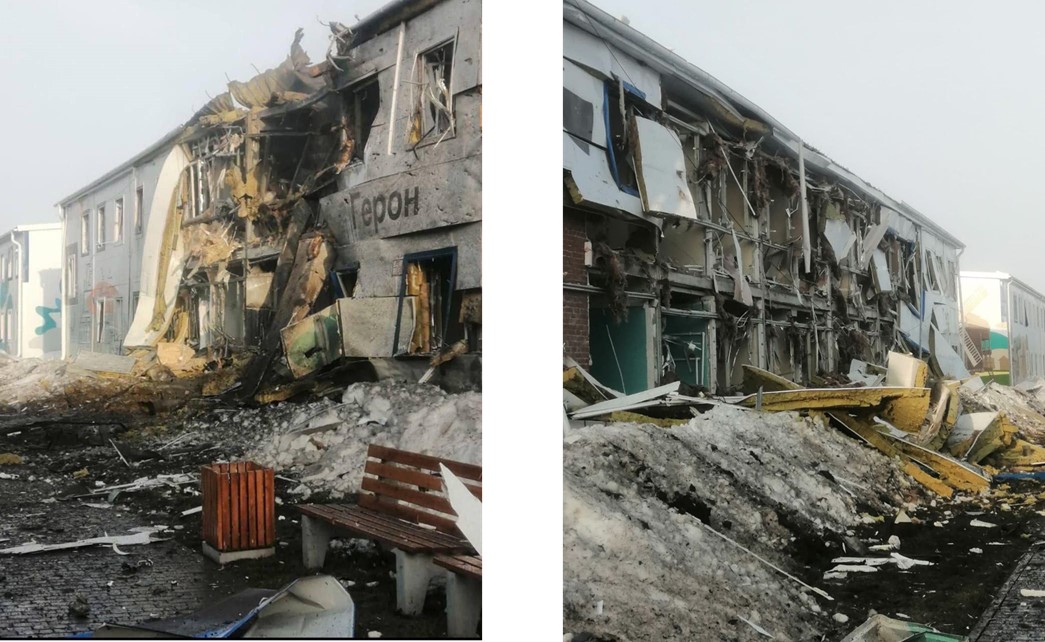Reports
Assessment of the April 2024 Strike on Alabuga Special Economic Zone
by David Albright, Sarah Burkhard, and Spencer Faragasso
May 2, 2024
On the morning of April 2, 2024, a single, remotely piloted aircraft struck several buildings located at the Alabuga Special Economic Zone, Yelabuga, Tatarstan, Russia. Several videos and photos have spread across social media showing a sole, fixed wing aircraft crashing into a set of buildings and exploding. The attack on Alabuga SEZ appears to have resulted in damage to the dormitory facilities housing workers participating in the Alabuga Polytechnic University program at the SEZ (see Figures 1 and 2). The same day, a separate drone strike occurred at an oil refinery in Nizhnekamsk, Tatarstan, Russia.1
The drone strike served as an indirect attack against Shahed-136 (Geran 2) drone production taking place in nearby buildings. Polytechnic students have been a key source of workers at the drone factory. Well over a hundred students were trained in Iran in key aspects of making the Shahed-136 drone.
The Institute acquired a high-resolution Airbus Pleiades commercial satellite image from April 3, 2024, the day after the attack, which shows evidence of damage to the roof of a building in the dormitory complex (see Figure 3). Alabuga has moved hastily to repair the complex. An Airbus image from a week later, on April 10, 2024, shows progress in roof repair, and containers, likely containing equipment and materials, and vehicles used to repair the buildings (see Figure 4).
Commercial satellite imagery also offers a possible explanation for the unmanned aircraft not striking the drone factory directly: The two main production halls have light metal anti-drone cage structures on their roofs.

Figure 1. Ground images of the aftermath of the drone strike on the Polytechnic dormitories at Alabuga SEZ on April 2, 2024, posted on social media. 2

Figure 2. A snapshot from a video of the attack showing the aircraft and a comparison to an Aeroprakt-22, taken from Aeroprakt Aircraft’s website. 3
Figure 3. An Airbus Pleiades satellite image from April 3, 2024, showing damage to the roof of one building in the dormitory complex.

Figure 4. An Airbus Pleiades satellite image from April 10, 2024, showing the repair work being done at the dormitory complex.
Based on the available footage, the aircraft used in the Alabuga strike appears to be an Aeroprakt-22, modified to be remotely controlled and laden with explosives (see Figure 2). Aeroprakt-22’s are typically used as training aircraft. Its two-seated airframe enables the aircraft to carry a large explosive charge. The aircraft typically has a range of roughly 1,100 km (roughly 684 miles), beyond the range of the Alabuga SEZ from Eastern Ukraine. It is unclear where the aircraft was launched from, and whether it had additional modifications that enabled it to travel the great distance. Several possibilities exist for how the drone got to Alabuga. A drone launched from Ukraine would require additional fuel supplies and need to navigate the great distance through Russian controlled airspace undetected by air defenses. Additional fuel supplies would reduce the weight availability for explosives. If the aircraft was launched from within Russia, this would give it the highest likelihood of success by limiting its flight time through air defense coverage and allow the aircraft to be within range of Alabuga, maximizing its explosive payload. Such an operation would require extensive planning and infiltration of Russia, to find or bring an aircraft, equip the aircraft with the necessary explosives, and the prepare it for the unmanned flight.
No Damage at the Nearby Shahed-136 (Geran 2) Production Buildings
None of the available videos of the strike or recent commercial satellite imagery show any damage to the primary Shahed-136 (Geran 2) production facilities, located just a quarter mile down the road from the dormitories. It is unclear how the drone was able to penetrate so far into Russian airspace uncontested, and why the drone did not strike the more valuable production facilities, but possible explanations include: the production buildings have physical protection measures that would have minimized the drone’s ability to cause damage, the production buildings were assessed as too large for the drone to cause significant damage even in a successful strike, or the production buildings were indeed the intended target and the strike on the dormitories was an intended or unintended last-minute diversion because of another countermeasure, such as electronic warfare interference with the drone.
Further analysis of satellite imagery reveals that the production plant indeed has physical defensive measures specifically designed to minimize damage by attacks from unmanned aerial vehicles. The two main buildings where Shahed-136 drones are produced appear to have a light metal anti-drone cage structure installed on their roofs (see Figure 5). This structure is designed to cause any explosive laden drone to explode on contact with the cage rather than the roof of the actual building, limiting any possible damage. These so-called anti-drone cages have become increasingly common, and Russia is known to use them to protect tanks and other assets, including an oil refinery. 4 Based on available satellite imagery, the anti-drone cage was installed in the summer of 2023, months before the attack, in parallel with Alabuga installing additional security measures, including a physical security wall and entrance checkpoints. 5 Similar anti-drone cage structures are used by Iran to protect valuable, above-ground production sites, such as its pilot uranium enrichment plant at Natanz. 6 However, it could not be determined how effective the Alabuga drone cages would be against a large drone with tens of kilograms of high explosives.
Figure 5. An April 10, 2024, Airbus Pleiades commercial satellite image of the Shahed-136 production plant at JSC Alabuga SEZ shows no damage to the buildings, which are protected by elevated anti-drone cage installed on the roof.
Backbone of Shahed-136 Workforce
Social media posts by Alabuga Polytechnic University showing the dormitories where its participants live correspond to the buildings recorded in the strike (see Figures 6 and 7). Ukrainian media reports that there were more than a dozen casualties amongst the workers, although no deaths. 7 It is known from internal Alabuga documents that a large number of Alabuga Polytechnic University students work in JSC Alabuga’s drone production facility to produce Shahed-136 drones. 8
Following the attack, Alabuga SEZ posted a statement on its VKontakte social media page condemning the attack and confirming that the buildings were the dormitories. 9 An Alabuga Polytechnic worker stated, “Those who attacked our hostel are real barbarians and deserve very serious condemnation. In my opinion, the goal was to intimidate us, I want to tell you that they did not succeed.” Nonetheless, Alabuga depends extensively on Polytechnic students to make the Shahed-136 drones, especially the airframe, which is labor intensive. Likely, the attack scared a fraction of the students, or prospective students, especially women who do not have the incentive to stay or work there in order to avoid being drafted into military service. In addition, it is known from internal Alabuga personnel lists that many Polytechnic students travelled to Iran to learn how to make Shahed-136 drones. An early February 2023 Alabuga spreadsheet, under a section titled, Education, also lists that “at least 100 students and 10 staff” were to be sent for two months of training as part of the process of making the drone airframe, a training session which started on March 3, 2023, and finished on May 2, 2023. These students could be subject to Western sanctions, giving the students yet another reason to leave or prospective students an incentive to seek other educational opportunities.

Figure 6. Ground photos from the attack are correlated with a satellite image pre-dating the attack to confirm that the drone struck the dormitories. 10

Figure 7. A Telegram post by Alabuga Start, the program operated by Alabuga Polytechnic University, showing the dormitories that house its participants. The buildings are the same as seen in videos of the attack. 11
1. Guy Faulconbridge and Vladimir Soldatkin, “Ukrainian drone hits Russia’s third-biggest refinery, damage not critical,” Reuters, April 2, 2024, https://www.reuters.com/world/europe/several-people-injured-drone-attack-industrial-sites-russias-tatarstan-agencies-2024-04-02/. ↩
2. @Nexta_TV , “Drones attacked enterprises in Yelabuga and Nizhnekamsk in Tatarstan for the first time,” X.com, April 2, 2024, https://twitter.com/nexta_tv/status/1775043053083877743/photo/4 ; @IAPonomarenko, “Meanwhile at the Shahed drone factory in Russia’s Tatarstan,” X.com, April 2, 2024,https://twitter.com/IAPonomarenko/status/1775050929013702865/photo/2.↩
3. “Aeroprakt-22,” Aeroprakt Aircraft. ↩
4. Vladimir Soldatkin, “Russia’s Bashneft oil company installs anti-drone nets to protects refineries, says report,” Reuters, April 19, 2024, https://www.reuters.com/world/europe/russias-bashneft-protects-refineries-with-anti-drone-nets-ria-says-2024-04-19/. ↩
5. David Albright, Sarah Burkhard, and the Good ISIS team, “Visible Progress at Russia’s Shahed Drone Production Site Satellite Imagery Update and Call for Action,” Institute for Science and International Security, November 13, 2023, https://isis-online.org/isis-reports/detail/visible-progress-at-russias-shahed-drone-production-site. ↩
6.https://twitter.com/TheGoodISIS/status/1621204113412194306?s=20. ↩
7. “All 13 Casualties From Tatarstan Drone Attack Were Students Employed at Kamikaze Drone Factory,” Kyiv Post, April 2, 2024, https://www.kyivpost.com/post/30492. ↩
8. See also, “Alabuga. Iranian drones franchise,” Protokol, July 3, 2023, https://protokol.band/2023/07/03/alabuga-iranskie-drony/. ↩
9. “Alabuga is a strong place. Don’t scare me.” SEZ Alabuga, April 3, 2024, https://vk.com/sezalabuga?w=wall-39536822_4146. ↩
10. @Nexta_TV , “Drones attacked enterprises in Yelabuga and Nizhnekamsk in Tatarstan for the first time,” X.com, April 2, 2024, https://twitter.com/nexta_tv/status/1775043053083877743?s=46. ↩
11. “Accommodation (hostels),” Alabuga Start Program, June 20, 2023, https://t.me/AlabugaStart/74?single. ↩



 twitter
twitter